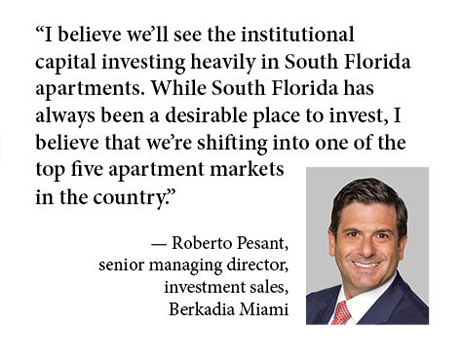Multifamily & Affordable Housing Business sat down with Roberto Pesant, senior managing director of investment sales with Berkadia’s Miami office, to discuss the demand for luxury communities in Miami — from both renters and investors.
MAHB: The latest Berkadia report forecasts that average effective rent will be $2,569 by the fourth quarter of this year. Is the market overbuilt toward Class A/luxury properties, and if so, who’s renting these pricey units?
Roberto Pesant: Demand for the urban, luxury product is coming from a number of sources. Some part of it comes from the continued job growth. Some part of the demand is a byproduct of the high single-family home values. We’re seeing both would-be, first-time home buyers as well as downsizing home sellers find the luxury rental market to be an attractive alternative to buying a home at the current pricing levels. In other words, the monthly rent on a new Brickell high-rise provides the tenant with a lot more “luxury” than a comparable mortgage payment would today.
MAHB: According to MSCI Inc., total sales volume for South Florida totaled $3.2 billion in 2023, down 65 percent from 2022. Do you expect more multifamily trades to occur in 2024? Why?
Pesant: I do, assuming we see stability in the capital markets and declining interest rates, then more buyers and sellers should be able to agree on asset pricing and transact.
MAHB: In 2023, we heard a lot about capital that’s been sitting on the sidelines, riding out the unstable-interest-rate environment. Can you provide a little more insight and color about this pent-up investor demand and how it might play out in Miami? What types of assets are most likely to sell and in what areas and to what type of buyers — and when might that happen?
Pesant: I believe we’ll see the institutional capital investing heavily in South Florida apartments. While South Florida has always been a desirable place to invest, I believe that we’re shifting into one of the top five apartment markets in the country.
MAHB: Berkadia’s 2024 forecast report indicates that 16,178 units were delivered while 9,297 were absorbed. Will occupancies and rent growth go down as a result of figures such as these?
Pesant: The real story on South Florida apartment deliveries has always been absorption. The region has historically fully absorbed its new supply. Full absorption is easy to forecast, as the total number of new construction deliveries expected between 2025 and 2027 is so small.


